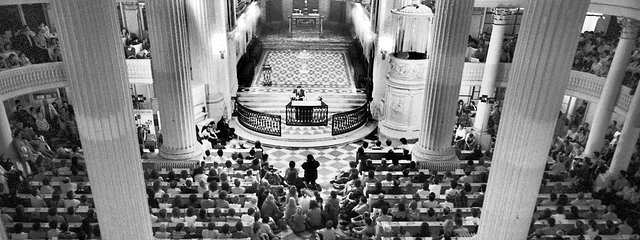
The miracle of Leipzig
The ninth in a series on the spiritual revolution behind the fall of communism thirty years ago:
Thirty years ago this week, a remarkable event took place in the eastern Germany city of Leipzig, inspiring millions to take to the streets across the country and to tear down the Berlin Wall exactly one month later.
The Nikolaikirche was the starting point of this movement of peaceful rebellion against the oppressive communist rule. The church was founded in about 1165 at the junction of two important trade routes, north-south and east-west, and named after the patron-saint of merchants. Luther is said to have preached here. Johan Sebastian Bach was master and organist of the choir, from 1723 to 1750. Many of his compositions were heard for the first time in this church.
The angel of peace above the altar was painted centuries before peace prayer services were begun, each Monday evening in the church in 1982. A protest movement against the arms race, and for justice and human rights, began to grow in the DDR (East Germany). The church became the focus for such discontent, including agitation for the right to emigrate. Believers and non-believers alike prayed, discussed and studied the contemporary relevance of the Old Testament prophets and the teachings of Jesus. The church was the one institution in the DDR that seemed to offer protection from the Stasi (State Security Police).
RADICAL IDEA
The pastor of the Nikolaikirche, Christian Führer, relished the chance to speak to a captive audience on the Sermon on the Mount. He also publicly supported those who wished to emigrate. But by late summer 1988, a more radical idea had taken hold: stay and agitate for a free and democratic Germany.
In February 1989, police broke up a rally calling for democracy and freedom. But the Friedensgebete continued to grow and, by the spring, the authorities saw the prayer meetings as a threat. Access for cars to the church were blocked. Even the closest motorway exits were closed off or subjected to large-scale checks.
By the autumn of 1989, the movement was approaching its climax. The Nikolaikirche continued to be open for all: true worshippers, the discontents, the curious, the Stasi and their collaborators, all gathering beneath the outstretched arms of the crucified and resurrected Jesus. Flowers decorated the church’s windows; candles multiplied throughout the building as silent signs of hope. Throughout all, a spirit of peace reigned. Crowds continued to gather at the church. Some demanded the freedom to leave the country; others declared their commitment to stay. The authorities tried to pressure the church leaders to cancel the peace prayers. Police surrounded the church and began making brutal arrests. Each Monday more arrests were being made, yet more visitors flocked to the church, overflowing its 2000 seats.
On 25th September, Pastor Christoph Wonneberger criticised state violence in his sermon and demanded democratic change through peaceful means. At the end of the service, crowds walked around the city’s ring road, gathering support until they were 8,000 strong. The following Monday, 2nd October, 20,000 marched to the Thomaskirche on the far side of the city, where they were met by riot police with shields, helmets and truncheons.
PROVOCATION
October 7 was the 40th anniversary of the DDR, an occasion for widespread protest. Police waded into protesters, arresting many and hauling them off to horse stables.
Two days later, October 9, a thousand Stasi collaborators were sent to the Nikolaikirche to ‘prevent provocations’. By early afternoon, 600 of them had taken up positions inside the church. By mid-afternoon the church was full and late-comers filled up seven other churches in the city centre by 5pm.
After the prayers, the 2000 congregants filed out of the building with their candles, to be greeted by 10,000 peace protestors outside. Waiting soldiers, paramilitaries and police began to move into the crowd seeking provocation, but no-one allowed themselves to react in violence.
Pfarrer Führer described what happened: ‘If you carry a candle, you need two hands. You have to prevent the candle from going out. You cannot hold a stone or a club in your hand. And the miracle came to pass. Jesus’ spirit of nonviolence seized the masses and became a material, peaceful power. Troops, industrial militia groups, and the police were drawn in, became engaged in conversations, then withdrew. It was an evening in the spirit of our Lord Jesus for there were no victors or vanquished, no one triumphed over the other, and no one lost face.’
Later the head of the Stasi admitted: ‘We were prepared for everything, except prayers and candles.’
The following Monday, 150,000 disciplined protestors walked through the city. The next week there were 300,000. A movement inspired by prayer, the teachings of Jesus and the courage of church leaders to stand for truth and justice was spreading across the country.
In spite of Eric Honecker’s claim on October 7th–at the 40th anniversary commemorations–that the Berlin Wall would last another hundred years, it hardly lasted another month. The soft powers of love, truth and justice had finally prevailed over brick-and-mortar expressions of division, deceit and injustice.
Jeff Fountain
Director Schuman Centre
For more weekly words from Jeff, visit weeklyword.eu.

This Post Has 0 Comments